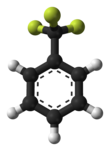|
Trifluorotoluene
Trifluorotoluene is an organic compound with the formula of C6H5CF3. This colorless fluorocarbon is used as a specialty solvent in organic synthesis and an intermediate in the production of pesticides and pharmaceuticals.[1] SynthesisFor small-scale laboratory preparations, trifluorotoluene is synthesized by coupling an aromatic halide and trifluoromethyl iodide in the presence of a copper catalyst:[2]
Industrial production is done by reacting benzotrichloride with hydrogen fluoride in a pressurized reactor.[3]
UsesTrifluorotoluene has a variety of niche uses. Low toxicity alternative to dichloromethaneAccording to Ogawa and Curran, trifluorotoluene is similar to dichloromethane in standard acylation, tosylation, and silylation reactions.[4] The dielectric constants for dichloromethane and trifluorotoluene are 9.04 and 9.18, respectively, indicating similar solvating properties. Dipole moments compare less favorably: 1.89 and 2.86 D for dichloromethane and trifluorotoluene, respectively. Replacing dichloromethane is advantageous when conditions require higher boiling solvents, since trifluorotoluene boils at 103 °C it has a higher boiling point than dichloromethane, which has a boiling point of ~40 °C. As a solvent, trifluorotoluene is useful in mild Lewis-acid catalyzed reactions, such as the Friedel-Crafts preparations. The most common catalyst, aluminium trichloride reacts with trifluorotoluene at room temperature; however, zinc chloride does not. Synthetic intermediateA second and perhaps more valuable use of trifluorotoluene is as a synthetic intermediate. A derivative of trifluorotoluene, 3-aminobenzotrifluoride, is the precursor to the herbicide fluometuron.[3] It is synthesized via nitration followed by reduction to meta-H2NC6H4CF3. This aniline is then converted to the urea. Flumetramide (6-[4-(trifluoromethyl)phenyl]morpholin-3-one), a skeletal muscle relaxant, is also prepared from trifluorotoluene.[1] AnalyticsTrifluorotoluene appears in 19F NMR as a singlet at -63.2 ppm.[5] References
|
||||||||||||||||||||||||||||||||||||||||||||||||||||||||||||||


